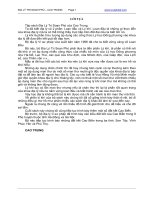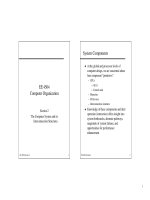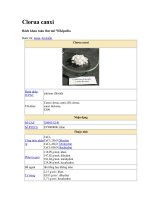Tài liệu TRANSIENT ANALYSIS pdf
Bạn đang xem bản rút gọn của tài liệu. Xem và tải ngay bản đầy đủ của tài liệu tại đây (302.41 KB, 33 trang )
Attia, John Okyere. “Transient Analysis.”
Electronics and Circuit Analysis using MATLAB.
Ed. John Okyere Attia
Boca Raton: CRC Press LLC, 1999
© 1999 by CRC PRESS LLC
CHAPTER FIVE
TRANSIENT ANALYSIS
5.1 RC NETWORK
Considering the RC Network shown in Figure 5.1, we can use KCL to write
Equation (5.1).
RCV
o
(t)
Figure 5.1 Source-free RC Network
C
dv t
dt
vt
R
oo
() ()
+=
0
(5.1)
i.e.,
dv t
dt
vt
CR
oo
() ()
+=
0
If
V
m
is the initial voltage across the capacitor, then the solution to Equation
(5.1) is
vt Ve
m
t
CR
0
()
=
−
(5.2)
where
CR is the time constant
Equation (5.2) represents the voltage across a discharging capacitor. To obtain
the voltage across a charging capacitor, let us consider Figure 5.2.
© 1999 CRC Press LLC
© 1999 CRC Press LLC
V
o
(t)
R
CV
s
Figure 5.2 Charging of a Capacitor
Using KCL, we get
C
dv t
dt
vt V
R
oos
() ()
+
−
=
0
(5.3)
If the capacitor is initially uncharged, that is
vt
0
()
= 0 at
t
= 0, the solution
to Equation (5.3) is given as
vt V e
S
t
CR
0
1()
=−
−
(5.4)
Examples 5.1 and 5.2 illustrate the use of MATLAB for solving problems
related to RC Network.
Example 5.1
Assume that for Figure 5.2
C
= 10 µF, use MATLAB to plot the voltage
across the capacitor if
R
is equal to (a) 1.0 kΩ, (b) 10 kΩ and (c) 0.1 kΩ.
Solution
MATLAB Script
% Charging of an RC circuit
%
c = 10e-6;
r1 = 1e3;
© 1999 CRC Press LLC
© 1999 CRC Press LLC
tau1 = c*r1;
t = 0:0.002:0.05;
v1 = 10*(1-exp(-t/tau1));
r2 = 10e3;
tau2 = c*r2;
v2 = 10*(1-exp(-t/tau2));
r3 = .1e3;
tau3 = c*r3;
v3 = 10*(1-exp(-t/tau3));
plot(t,v1,'+',t,v2,'o', t,v3,'*')
axis([0 0.06 0 12])
title('Charging of a capacitor with three time constants')
xlabel('Time, s')
ylabel('Voltage across capacitor')
text(0.03, 5.0, '+ for R = 1 Kilohms')
text(0.03, 6.0, 'o for R = 10 Kilohms')
text(0.03, 7.0, '* for R = 0.1 Kilohms')
Figure 5.3 shows the charging curves.
Figure 5.3 Charging of Capacitor
© 1999 CRC Press LLC
© 1999 CRC Press LLC
From Figure 5.3, it can be seen that as the time constant is small, it takes a
short time for the capacitor to charge up.
Example 5.2
For Figure 5.2, the input voltage is a rectangular pulse with an amplitude of 5V
and a width of 0.5s. If
C
= 10 µF, plot the output voltage,
vt
0
()
, for
resistance
R
equal to (a) 1000 Ω, and (b) 10,000 Ω. The plots should start
from zero seconds and end at 1.5 seconds.
Solution
MATLAB Script
% The problem will be solved using a function program rceval
function [v, t] = rceval(r, c)
% rceval is a function program for calculating
% the output voltage given the values of
% resistance and capacitance.
% usage [v, t] = rceval(r, c)
% r is the resistance value(ohms)
% c is the capacitance value(Farads)
% v is the output voltage
% t is the time corresponding to voltage v
tau = r*c;
for i=1:50
t(i) = i/100;
v(i) = 5*(1-exp(-t(i)/tau));
end
vmax = v(50);
for i = 51:100
t(i) = i/100;
v(i) = vmax*exp(-t(i-50)/tau);
end
end
% The problem will be solved using function program
% rceval
% The output is obtained for the various resistances
c = 10.0e-6;
r1 = 2500;
© 1999 CRC Press LLC
© 1999 CRC Press LLC
[v1,t1] = rceval(r1,c);
r2 = 10000;
[v2,t2] = rceval(r2,c);
% plot the voltages
plot(t1,v1,'*w', t2,v2,'+w')
axis([0 1 0 6])
title('Response of an RC circuit to pulse input')
xlabel('Time, s')
ylabel('Voltage, V')
text(0.55,5.5,'* is for 2500 Ohms')
text(0.55,5.0, '+ is for 10000 Ohms')
Figure 5.4 shows the charging and discharging curves.
Figure 5.4 Charging and Discharging of a Capacitor with Different
Time Constants
© 1999 CRC Press LLC
© 1999 CRC Press LLC
5.2 RL NETWORK
Consider the RL circuit shown in Figure 5.5.
L
R
V
o
(t)
i(t)
Figure 5.5 Source-free RL Circuit
Using the KVL, we get
L
di t
dt
Ri t
()
()
+=
0
(5.5)
If the initial current flowing through the inductor is
I
m
, then the solution to
Equation (5.5) is
it I e
m
t
()
=
−
τ
(5.6)
where
τ
=
L
R
(5.7)
Equation (5.6) represents the current response of a source-free RL circuit with
initial current
I
m
, and it represents the natural response of an RL circuit.
Figure 5.6 is an RL circuit with source voltage
vt V
S
()
=
.
© 1999 CRC Press LLC
© 1999 CRC Press LLC
V
R
(t)
L
R
i(t)
V(t)
Figure 5.6 RL Circuit with a Voltage Source
Using KVL, we get
L
di t
dt
Ri t V
S
()
()
+=
(5.8)
If the initial current flowing through the series circuit is zero, the solution of
Equation (5.8) is
it
V
R
e
S
Rt
L
()
=−
−
1
(5.9)
The voltage across the resistor is
vt Rit
R
() ()
=
=
Ve
S
Rt
L
1
−
−
(5.10)
The voltage across the inductor is
vt V vt
LSR
() ()
=−
=
−
Ve
S
Rt
L
(5.11)
The following example illustrates the use of MATLAB for solving RL circuit
problems.
© 1999 CRC Press LLC
© 1999 CRC Press LLC
Example 5.3
For the sequential circuit shown in Figure 5.7, the current flowing through the
inductor is zero. At
t
= 0, the switch moved from position a to b, where it
remained for 1 s. After the 1 s delay, the switch moved from position b to
position c, where it remained indefinitely. Sketch the current flowing through
the inductor versus time.
40V
50 Ohms
150 Ohms
200 H
50 Ohms
a
b
c
Figure 5.7 RL Circuit for Example 5.3
Solution
For 0 < t < 1 s, we can use Equation (5.9) to find the current
it e
t
() .
=−
−
04 1
1
τ
(5.12)
where
τ
1
200
100
2
== =
L
R
s
At t = 1 s
()
it e
() .
.
=−
−
041
05
(5.13)
=
I
max
For
t
> 1 s, we can use Equation (5.6) to obtain the current
it I e
t
()
max
.
=
−
−
05
2
τ
(5.14)
© 1999 CRC Press LLC
© 1999 CRC Press LLC
where
τ
2
2
200
200
1
== =
L
R
eq
s
The MATLAB program for plotting
it
()
is shown below.
MATLAB Script
% Solution to Example 5.3
% tau1 is time constant when switch is at b
% tau2 is the time constant when the switch is in position c
%
tau1 = 200/100;
for k=1:20
t(k) = k/20;
i(k) = 0.4*(1-exp(-t(k)/tau1));
end
imax = i(20);
tau2 = 200/200;
for k = 21:120
t(k) = k/20;
i(k) = imax*exp(-t(k-20)/tau2);
end
% plot the current
plot(t,i,'o')
axis([0 6 0 0.18])
title('Current of an RL circuit')
xlabel('Time, s')
ylabel('Current, A')
Figure 5.8 shows the current
it
()
.
© 1999 CRC Press LLC
© 1999 CRC Press LLC
Figure 5.8 Current Flowing through Inductor
5.3 RLC CIRCUIT
For the series RLC circuit shown in Figure 5.9, we can use KVL to obtain
the Equation (5.15).
V
o
(t)
L
R
V
s
(t) = V
s
i(t)
Figure 5.9 Series RLC Circuit
© 1999 CRC Press LLC
© 1999 CRC Press LLC
vt L
di t
dt C
id Rit
S
t
()
()
() ()
=+ +
−∞
∫
1
ττ
(5.15)
Differentiating the above expression, we get
dv t
dt
L
dit
dt
R
di t
dt
it
C
S
()
() () ()
=++
2
2
i.e.,
1
2
2
L
dv t
dt
dit
dt
R
L
di t
dt
it
LC
S
()
() () ()
=+ +
(5.16)
The homogeneous solution can be found by making
vt
S
()
= constant, thus
0
2
2
=+ +
dit
dt
R
L
di t
dt
it
LC
() () ()
(5.17)
The characteristic equation is
0
2
=++
λλ
ab
(5.18)
where
a
R
L
=
and
b
LC
=
1
The roots of the characteristic equation can be determined. If we assume that
the roots are
λαβ
=
,
then, the solution to the homogeneous solution is
it Ae Ae
h
tt
()
=+
12
12
αα
(5.19)
where
© 1999 CRC Press LLC
© 1999 CRC Press LLC
A
1
and
A
2
are constants.
If
vt
S
()
is a constant, then the forced solution will also be a constant and be
given as
it A
f
()
=
3
(5.20)
The total solution is given as
it Ae Ae A
tt
()
=++
12 3
12
αα
(5.21)
where
A
1
,
A
2
,
and
A
3
are obtained from initial conditions.
Example 5.4 illustrates the use of MATLAB for finding the roots of
characteristic equations. The MATLAB function roots, described in Section
6.3.1, is used to obtain the roots of characteristic equations.
Example 5.4
For the series RLC circuit shown in Figure 5.9, If
L
= 10 H,
R
= 400 Ohms
and
C
= 100µF,
vt
S
()
= 0,
i
()04
=
A and
di
dt
()0
15
=
A/s, find
it
()
.
Solution
Since
vt
S
()
= 0, we use Equation (5.17) to get
0
400
10
1000
2
2
=+ +
dit
dt
di t
dt
it
() ()
()
The characteristic equation is
0 40 1000
2
=+ +
λλ
The MATLAB function roots is used to obtain the roots of the characteristics
equation.
© 1999 CRC Press LLC
© 1999 CRC Press LLC









